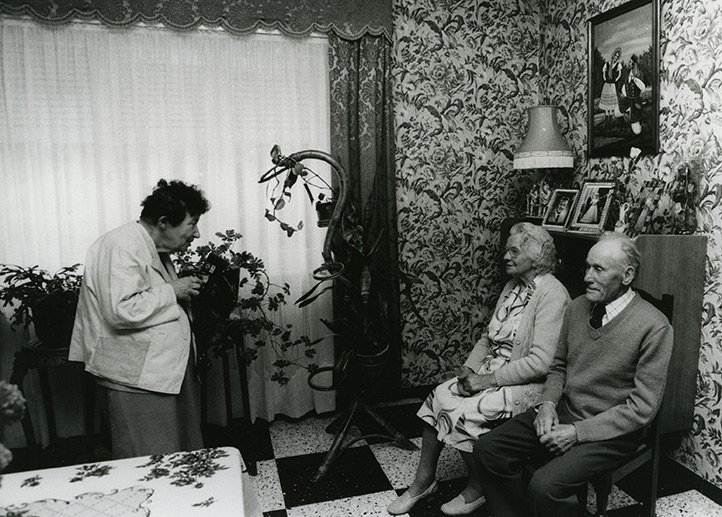Zofia Rydet, “On Her Work,” Wydawnictwo Muzeum w Gliwicach, Gliwice 1993
In 1978, I began my Sociological Record (...) [which] was meant to be a way of embalming time. It was (or is) supposed to preserve what is changing, for a time when what remains now a reality ceases to exist and might be very difficult to imagine. It is meant to provide a faithful reflection of man in his surroundings, in his environment which he creates for himself, and which, on the one hand, decorates his immediate surroundings (his home interior), and on the other shows his psyche, and sometimes says more about him than he does himself.
(...)
My initial premise was: the objects and interiors are most important, while the people are only a facet that defines the interior, they are to be static, as if objects themselves, and so they have to sit facing the camera and stare into the lens; the photographs always have to be taken with the same camera, the same lighting, and more or less the same point of view. After all, this was to be a simple, objective, authentic record of the existing reality, taken from a detached perspective.
At the same time, I noticed even while I was doing the work that it was taking on an entirely different color, that these ordinary documentary photographs were becoming, before my eyes, a great truth about human fate, that I was unable to maintain my detachment; on the contrary, it was drawing me in more than anything I had ever done before; it was becoming my new love, my passion, bringing me new perspectives and strengths.
A man, who was meant to be just another part of the whole, turned out to be the most important, and his staring directly into the lens created a very strong link between us: model–camera–photographer. The model realized the “gravity of the moment” in staring straight into the camera, that he was being immortalized, the capturing of his personality or even himself, that he was being ennobled to become a symbol of sorts, though he himself was not a great man. The photographer was a powerful magician with the ability to stop time, defeating the hydra of time for a brief second. The camera was the main instrument, an enchanted box that could freeze an image in time.

And thus it became almost a narcotic. Walking all day through villages and towns, entering homes and meeting such varied people, I forgot I was lugging around a heavy camera, that my back hurt, that it was hard for me to walk all day. Those meetings with people, which always felt new and interesting, gave me strength. At the same time they taught me new philosophies, new values and relationships to the most important matters, i.e. life and death.
I took over thirty thousand photographs in twenty voivodeships, mostly in villages, whose landscapes are changing every year with astonishing speed; the old straw huts are vanishing, along with the small wooden houses that typify various regions. The huts with rows of holy pictures are also vanishing.
Boxes with flat roofs, the same ones all across Poland, are being created at enormous speed, often decorated with mirror or glass. There are no more wooden walls, and inside there are knick-knacks from trinket shops, glasses painted with gold or cherry patterns, gnomes and dolls, stiff fake flowers, though there are beautiful fresh ones in the garden. This documentation of the truth of the modern-day man and his existence shows the transformations in society and in ways of thinking and aesthetic sensibility, and in ways of consumption. This is most evident when we compare the village and the city. Here, too, we see a rich diversity, between bureaucrats, craftsmen, scholars, and artists. For me almost every HOME is the image of a person. I have made a fairly precise documentation of this. I recently photographed vanishing handcrafts, especially village ones: smiths, potters. My Sociological Record is more than interiors. It includes heaps of other series, including photographs of huts, little houses, villas, etc. The village windows are very decorative from the inside.
In 1988, I spent twelve days in the small French town of Douchy, and I had managed to gather fairly in-depth documentary materials, from which I created the Sociological Record 1988 Douchy exhibition. In 1989, I was in Lithuania and in New York, where I also took pictures of people in their homes. That gave me a lot. People are the same everywhere, but their homes show crucial differences.
Last year I started a new series. My Record is documented. Having kept careful notes, I decided to return to those homes and those people. That was a cruel experience; time is merciless, and everything changes. People die, and their homes die with them. Not only people vanish, but everything that once surrounded them. Only photography can stop time. Only photography has the ability to defeat the specter of death. This is my ongoing struggle, with death and the passing of time.
These trips of mine (without a car) and meetings with various people have lost none of their fascination. I use my camera to take what is most fascinating from them, what is astonishing and unconventionally beautiful, and I have the profound hope that I manage to communicate this to others as well, thus sharing what I myself experience.
